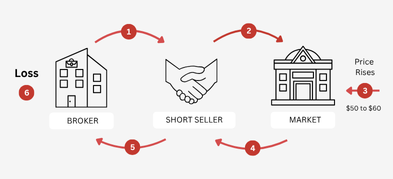
Ultima Markets App
Trade Anytime, Anywhere
Important Information
This website is managed by Ultima Markets’ international entities, and it’s important to emphasise that they are not subject to regulation by the FCA in the UK. Therefore, you must understand that you will not have the FCA’s protection when investing through this website – for example:
- You will not be guaranteed Negative Balance Protection
- You will not be protected by FCA’s leverage restrictions
- You will not have the right to settle disputes via the Financial Ombudsman Service (FOS)
- You will not be protected by Financial Services Compensation Scheme (FSCS)
- Any monies deposited will not be afforded the protection required under the FCA Client Assets Sourcebook. The level of protection for your funds will be determined by the regulations of the relevant local regulator.
Note: Ultima Markets is currently developing a dedicated website for UK clients and expects to onboard UK clients under FCA regulations in 2026.
If you would like to proceed and visit this website, you acknowledge and confirm the following:
- 1.The website is owned by Ultima Markets’ international entities and not by Ultima Markets UK Ltd, which is regulated by the FCA.
- 2.Ultima Markets Limited, or any of the Ultima Markets international entities, are neither based in the UK nor licensed by the FCA.
- 3.You are accessing the website at your own initiative and have not been solicited by Ultima Markets Limited in any way.
- 4.Investing through this website does not grant you the protections provided by the FCA.
- 5.Should you choose to invest through this website or with any of the international Ultima Markets entities, you will be subject to the rules and regulations of the relevant international regulatory authorities, not the FCA.
Ultima Markets wants to make it clear that we are duly licensed and authorised to offer the services and financial derivative products listed on our website. Individuals accessing this website and registering a trading account do so entirely of their own volition and without prior solicitation.
By confirming your decision to proceed with entering the website, you hereby affirm that this decision was solely initiated by you, and no solicitation has been made by any Ultima Markets entity.
I confirm my intention to proceed and enter this website Please direct me to the website operated by Ultima Markets , regulated by the FCA in the United KingdomWhy Invest in U.S. Stocks?
The U.S. is the world’s largest economy with a robust trading system
The United States is the world’s largest economy and boasts the largest stock market by trading volume, with a well-established trading system. The U.S. economy accounts for approximately 60% of the global economy, giving it significant influence over global markets.
The U.S. stock market has a massive market capitalization, offering excellent liquidity and transparency, which means the market is less prone to manipulation and provides a stable trading environment for investors. Compared to the Taiwanese stock market, the U.S. stock market is more mature and stable. Additionally, about 80% of U.S. stock market participants are institutional investors, who tend to be more disciplined than retail investors. Institutional investors typically undergo strict company review mechanisms for stock trading, resulting in fewer speculative behaviors and a more rational market overall.
The regulatory mechanisms of the U.S. stock market are also highly reliable. The SEC (U.S. Securities and Exchange Commission), as the agency overseeing the market and protecting investors, has zero tolerance for insider trading, financial fraud, and other malpractices, striving to enhance market transparency and create a fair and investor-friendly environment.
U.S. stocks include many globally renowned companies
The U.S. stock market is the most open and mature financial market globally, attracting many large companies from other countries to list their shares. For example, Taiwan’s TSMC (TSM), Japan’s Sony (SONY), the Netherlands’ ASML (a lithography machine manufacturer), and Germany’s BMW (BMWYY) are all traded on the U.S. stock market. Additionally, many well-known domestic companies like Apple (AAPL), Starbucks (SBUX), and McDonald’s (MCD) have a global presence and are familiar to investors. This familiarity gives investors more confidence, as the companies they invest in are often closely tied to everyday life.
Note: Besides U.S.-based companies, many large companies from other countries also trade on the U.S. stock market through ADRs (American Depositary Receipts). ADRs allow investors to invest in high-quality companies from other countries, further expanding their investment opportunities.
Beginner’s Guide to U.S. Stocks: 10 Trading Rules
Before diving into U.S. stock investments, understanding the basic trading rules is crucial. It’s like playing a game—how can you expect to win if you don’t know the rules? This section will walk you through the trading rules of U.S. stocks, helping beginners quickly grasp the fundamentals.
-
S. Stock Trading Hours
U.S. stock trading hours differ from those in Taiwan and are affected by Daylight Saving Time (DST) and Standard Time. The U.S. adjusts to DST in spring and reverts to Standard Time in fall. Specific trading hours are as follows:
- S. Local Time: 09:30–16:00
- Taiwan DST (mid-March to mid-November): 21:30–04:00
- Taiwan Standard Time (mid-November to mid-March): 22:30–05:00
-
Trading Units
Unlike Taiwanese stocks, which trade in units of 1,000 shares, U.S. stocks trade in units of 100 shares. This means even for the “same stock,” the trading unit in the U.S. market is significantly different.
-
Trading Fees
Trading fees for U.S. stocks are relatively low. Although investors need to wire funds to overseas brokers, wire transfer fees typically range from 800 to 1,500 NTD and are incurred only every few months.
-
Settlement Time
S. stocks follow a T+2 settlement cycle, meaning transactions are settled two business days after the trade. Since September 5, 2017, the settlement period was shortened from T+3 to T+2, allowing faster fund transfers after trades.
-
Price Limits
Unlike Taiwanese stocks, S. stockshave no price limits. However, some companies’ stock prices may experience significant fluctuations within a single day, especially for financially sound companies, where price swings exceeding 10% are not uncommon. Such volatility presents both opportunities and risks, requiring cautious trading.
-
Circuit Breaker Mechanism
The U.S. stock market’s circuit breaker mechanism is rarely triggered. Apart from a brief period during the pandemic, the last time it was activated was in the 1990s. Essentially, this mechanism acts as a “fuse” for the U.S. stock market, preventing excessive volatility and maintaining market stability.
Specific circuit breaker rules are as follows:
- 7% drop: Trading halts for 15 minutes.
- 13% drop: Trading halts again for 15 minutes.
- 20% drop: The market closes early for the day.
This rule aims to prevent market panic and give investors time to react.
-
Earnings Report Season
S. companies typically release their earnings reports in the third week of January, April, July, and October. While not all companies adhere to this schedule, many large companies do, making it the “super earnings season.”
The impact of earnings season on the market doesn’t always lead to significant volatility. For long-term value investors, the effects of earnings season may be minimal. If you’re a fundamentals-based investor, market fluctuations during this period may not require much attention. -
Stock Tickers
S. stock tickers usually consist of 1 to 5 letters, often abbreviations of company names for easy memorization. For example:
- Starbucks: SBUX
- McDonald’s: MCD
- Coca-Cola: KO
Additionally, if a ticker has five letters and ends with Y or F, it indicates an over-the-counter (OTC) stock, which typically incurs higher trading fees.
-
Stock Splits
When a company’s stock price becomes too high, it may conduct a stock split to attract more investors. This process reduces the face value per share while increasing the number of shares, keeping the total value unchanged. For example, if you own 1 share of Google worth 1,000,aftera10−for−1split,youwouldown10sharesworth1,000,aftera10−for−1split,youwouldown10sharesworth100 each, with the total value remaining at $1,000.
Stock splits do not affect investors’ capital; they simply represent the value in more shares. -
Tax Considerations
- Dividend Tax for Non-U.S. Residents: 30%
S. stocks impose a 30% tax on dividends for foreign investors. This tax is withheld by brokers before dividend distribution, meaning investors receive the net amount after tax. However, dividend tax rates may be lower for investors from certain countries, depending on tax treaties. - Reporting Overseas Income
S. stock dividends are considered overseas income. For Taiwanese investors, these must be reported to the Taiwanese tax authorities during the annual income tax filing in May. Fortunately, Taiwan offers a high deduction threshold (7.5 million NTD) for overseas income, meaning no additional tax is owed if annual profits do not exceed this amount. - Tax Refunds
If you’ve paid the 30% dividend tax and wish to reclaim it, it is theoretically possible. However, the process is cumbersome and carries risks: - The refund application process is extremely complex, and fees (e.g., processing, postage) may exceed the refund amount.
- Once a refund is successfully claimed, your personal information will be recorded by the IRS, requiring accurate reporting in future tax filings. Any discrepancies may result in hefty fines.
- Estate Tax
If an investor passes away while holding U.S. stocks, their family has the right to inherit the investment assets. The estate must be transferred within nine months, and applicable estate taxes must be paid. The U.S. estate tax threshold is $60,000, with amounts above this taxed at progressive rates ranging from 15% to 35%.
Must-Know Guide to U.S. Stock Market: Understanding the Three Major U.S. Stock Indices
Unlike Taiwan’s Weighted Index, the U.S. stock market features three major stock indices: Dow Jones Industrial Average (DJIA), Nasdaq Composite, and S&P 500. Each index has its unique characteristics, representing different aspects of the U.S. stock market and serving as crucial global market indicators. Before investing in U.S. stocks, it is essential to understand how these indices are structured and how their fluctuations impact the market.
1. Dow Jones Industrial Average (DJIA)
- Index Code:DJI 30
- Constituent Stocks:30 large U.S. companies (mainly from traditional industries)
The Dow Jones Industrial Average (DJIA) is one of the oldest stock indices in the world. It was initially compiled by Dow Jones & Company in 1884 and officially published in 1896. This index consists of 30 large corporations that represent the economic strength of the United States, making it one of the key benchmarks for measuring U.S. stock market performance.
Although some argue that the DJIA does not fully represent the overall U.S. stock market due to its limited number of companies and focus on traditional industries, the included firms are generally global leaders. As a result, the DJIA remains a highly reputable market indicator for assessing stock market trends and economic signals.
2. Nasdaq Composite (NASDAQ)
- Index Code:NDX
- Constituent Stocks:100 large U.S. companies (mainly technology stocks)
Established in 1971, the Nasdaq Composite Index was created alongside the launch of the Nasdaq Stock Market. It functions similarly to Taiwan’s Weighted Index, as a composite stock index. The index includes approximately 5,000 stocks, mainly from technology-related industries such as advanced technology, telecommunications, biotechnology, software, semiconductors, and internet companies.
The Nasdaq Composite is widely regarded as the global benchmark for technology stocks. Almost all technology sectors worldwide reference its movements. Since the Nasdaq emphasizes high-tech industries, and technology stocks tend to be more volatile, this index plays a significant role in market trends.
3. S&P 500 Index
- Index Code:SPX
- Constituent Stocks:500 large U.S. companies (covering various industries)
The S&P 500 Index was created by Standard & Poor’s in 1957 and consists of the 500 largest publicly traded U.S. companies. These companies represent industry leaders across different sectors and have a significant market influence. Due to its strict selection criteria, the S&P 500 is widely recognized as a comprehensive indicator of U.S. stock market health.
Compared to the Dow Jones Industrial Average and Nasdaq Composite, the S&P 500’s diverse composition allows it to better reflect overall market movements. Many analysts use the S&P 500 as a key indicator for long-term stock market trends.
How to Invest in U.S. Stocks? The Three Main Investment Methods
1. U.S. Stock Sub-Brokerage
U.S. stock sub-brokerage refers to investors opening an account with a Taiwanese brokerage firm, which then places orders through an overseas brokerage firm. Since the transaction involves dual brokerage services, it is called sub-brokerage.
Advantages:
✅ Investor Rights Protection: Investors own actual U.S. stocks and enjoy shareholder rights, such as participating in shareholder meetings and receiving dividends.
✅ Convenience of Local Services: Trading through a Taiwanese broker eliminates language barriers and ensures compliance with Taiwan’s payment and tax regulations.
Disadvantages:
❌ Higher Transaction Costs: The involvement of two brokers typically increases fees and trading costs.
❌ Slower Execution Speed: Orders must go through a domestic broker before reaching an overseas broker, which may cause slower execution speeds compared to direct trading.
2. Overseas Brokerage Firms
Opening an account directly with an overseas brokerage firm is currently one of the most popular ways to invest in U.S. stocks. Some well-known international brokers that provide services to Taiwanese investors include: Firstrade, TD Ameritrade, and Interactive Brokers (IBKR).
Advantages:
✅ Lower Transaction Fees: Many overseas brokers offer low commissions and competitive exchange rates, making them ideal for long-term investors.
✅ Direct Market Access & Leverage Tools: Investors can trade U.S. stocks directly and use leverage tools for flexible capital allocation.
✅ Faster Trade Execution: Advanced trading platforms support real-time market data, making them suitable for traders who need quick execution.
Disadvantages:
❌ Complex Fund Transfers: Investors must handle foreign currency remittances, exchange rate fluctuations, and transfer fees.
❌ Language & Tax Challenges: Most platforms operate in English, and investors need to understand U.S. tax regulations for proper reporting.
3. Contracts for Difference (CFD)
A Contract for Difference (CFD) is a derivative financial instrument that allows investors to trade based on price movements without actually owning the underlying asset. This is a flexible option for short-term traders or small capital investors.
Advantages:
✅ Low Cost & Low Capital Requirement: Lower transaction fees, and leverage allows investors to participate with minimal capital.
✅ Profit from Falling Markets: CFDs offer short-selling capabilities, allowing investors to profit during market downturns.
✅ High Leverage: Allows for larger trading positions, making it suitable for high-risk, high-reward strategies.
Disadvantages:
❌ No Shareholder Rights: CFD traders do not own actual stocks, meaning no dividends or voting rights.
❌ High Risk: The use of leverage can lead to losses exceeding the initial capital, making CFDs suitable only for risk-tolerant investors.
❌ Hidden Costs: CFDs may involve overnight holding fees and interest charges, requiring investors to carefully review platform terms.
Comparison of U.S. Stock CFD, U.S. Stock Sub-Brokerage, and Overseas Brokers
| Trading Method | Contract for Difference (CFD) | U.S. Stock Sub-Brokerage | Overseas Broker |
| Trading Channel | CFD Brokers | Taiwan Securities Firms Act as Intermediaries | Direct Trading via Overseas Brokers |
| Leverage | Yes (1:20 to 1:50) | No | Varies by broker, usually 1:2 to 1:5 |
| Long & Short Trading | Allows short selling (Can go long or short on U.S. stocks) | Short selling not allowed | Cannot directly short U.S. stocks |
| Dividends & Corporate Actions | Yes (Some platforms provide dividend or adjustment) | Yes (Shareholder rights for holding U.S. stocks) | Yes (Shareholder rights for holding U.S. stocks) |
| Quote Type | Real-time quotes | Usually delayed (may have a few seconds of delay) | Real-time quotes (but may have trading time restrictions) |
| Overnight Interest | Yes (Charged based on leverage ratio) | No | Charged if leverage is used |
| Transaction Fees | Low (~0.1%) | Higher (0.25%~1%) | Usually lower (~0.1% to 0.5% depending on broker) |
| Trading Flexibility | High (Can freely open/close positions and short sell) | Medium (Can only trade stocks, no short selling option) | Medium to high (Allows stock trading, some brokers support leverage or derivative products) |
| Investment Threshold | Low (Can start trading with a small amount of capital) | Medium (Requires opening an account with a Taiwanese securities firm, higher entry threshold) | Low (Most overseas brokers have no minimum investment requirement) |
The above comparison covers the three main methods of trading U.S. stocks, considering leverage availability, short selling capability, fees, and flexibility. Investors can choose a method based on their trading preferences, whether they prefer flexibility or stability.
Choosing a Secure CFD Trading Platform
If you choose to trade U.S. stocks via CFDs, selecting a regulated platform is crucial for ensuring fund security and fair trading conditions. A broker that holds multiple licenses from the top five financial regulators is considered more reliable:
- Financial Conduct Authority (FCA) – United Kingdom
- Australian Securities and Investments Commission (ASIC) – Australia
- National Futures Association (NFA) – United States
- Markets in Financial Instruments Directive (MiFID) – European Union
- Cyprus Securities and Exchange Commission (CySEC) – Cyprus
These regulatory agencies require platforms to segregate client funds, ensuring that investor capital is not misused and remains protected.
Why Choose UM (Ultima Markets) for U.S. Stock CFD Trading?
The author frequently uses and trades U.S. stock CFDs on Ultima Markets (UM), which is regulated by CySEC (Cyprus), ASIC (Australia), and FSC (Mauritius). This ensures investor funds are protected.
Additionally, all UM customers are covered by Willis Towers Watson (WTW), a global insurance brokerage firm founded in 1828, with worldwide coverage. Each trading account is insured for up to $1 million, further enhancing investor protection.

Secondly, UM (Ultima Markets) is a company under the Australian renowned real estate developer Viapac Group (Pan Pacific Group). It offers trading in over 60 forex currency pairs, as well as precious metals like gold and silver, US stocks, stock indices, and various financial products including Bitcoin. Moreover, UM (Ultima Markets) provides 0 commission, low spreads, and leverage options ranging from 1 to 2000, with a minimum trade size as low as 0.01 lots. The UM (Ultima Markets) trading software is equipped with various trading tools such as stop loss, take profit, trailing stop, and real-time trading signals.
Therefore, UM (Ultima Markets) is a worthy consideration among all CFD brokers.
On the UM (Ultima Markets) trading platform, you can first open a demo account to trade US stocks, review the order process, learn how to set stop-loss points, watch the market, and read charts. Once you are proficient, you can switch to a live trading account. This approach not only avoids misoperations but also builds your confidence for real investments.
Demo trading is an ideal learning method for beginners investing in US stocks, helping you to:
Familiarize yourself with platform operations and market trends.
Test trading strategies without bearing actual risks.
Build confidence in a safe environment, preparing you for entering the real market.
How to buy US stocks? Common questions for beginners in US stocks
Q1. Which trading platform is recommended for beginners in US stocks?
First, consider brokers that are large-scale, fully licensed, and have a long establishment history. The author recommends using UM (Ultima Markets). UM not only provides a trading platform for US stock investments but also has a dedicated app, allowing investors to easily monitor market data, set personalized charts, and perform convenient order operations. Additionally, UM supports precious metals, commodities, indices, etc., making it a good choice for investors interested in expanding into other investment areas.
Q2. What should I do if I have never used a trading platform before for US stock investments?
On the UM (Ultima Markets) trading platform, you can first open a demo account to trade US stocks, review the order process, learn how to set stop-loss points, watch the market, and read charts. This way, you can familiarize yourself with platform operations without any risk. Once you are proficient, you can switch to a live trading account. This approach not only avoids misoperations but also builds your confidence for real investments.
Q3. My English is very poor, is it suitable for me to use a trading platform to invest in US stocks?
Many US stock investment beginners worry that their poor English skills will hinder their use of trading platforms. In fact, many trading platforms already offer Chinese customer service and interfaces, so investors need not worry about language barriers. Platforms like UM (Ultima Markets) have Chinese interfaces and provide 5x24H Chinese customer service. Regardless of your English proficiency, you can smoothly conduct trades.
Q4. What do I need to prepare to invest in US stocks?
Opening an account for beginners investing in US stocks is not complicated, but you need to provide some basic identity verification documents, such as a valid ID, proof of address, and bank account information. Before opening an account, it is recommended to understand the fee structures, platform features, and other investment products of different brokers, and choose the most suitable platform for registration.












